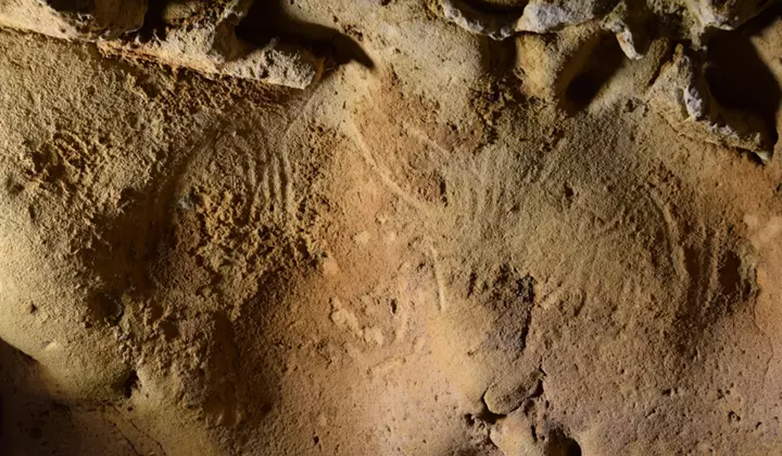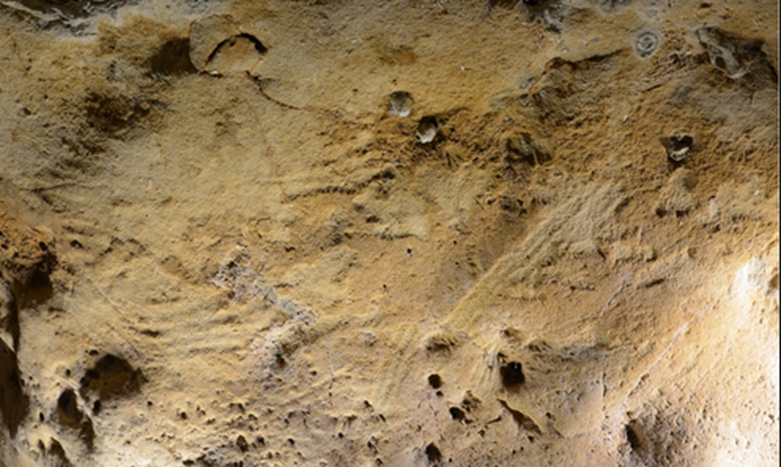The Neanderthals would have created the oldest engravings in France, and perhaps in Europe, more than 57,000 years ago

Image of one of the engravings, from the study of Marquet JC, Freiesleben TH, Thomsen KJ, Murray AS, Calligaro M, Macaire JJ, et al. (2023) The earliest unambiguous Neanderthal engravings on cave walls: La Roche-Cotard, Loire Valley, France. PLoS ONE 18(6): e0286568.
According to a recent press release from the CNRS, parietal engravings in the cave of La Roche-Cotard (Indre-et-Loire) have just been dated at more than 57,000 years, and probably date back to around 75,000 years.

The engravings, made with the fingers, discovered in 1970, according to the archaeologist Jean-Claude Marquet, would be the oldest in France, and probably in Europe, known to date. In the paper published in the journal PlosOne this Wednesday, June 21, 2023, an international team of paleontologists and geologists maintains that it is the work of the Neanderthals , Homo sapiens having appeared in Europe, there is ' 'only' 54,000 years old.
Parietal traces made with the fingers
Those who are not careful could miss the traces left on the orange wall of the Roche-Cotard cave. Lines, some of which resemble curves left by children in the sand, adorn the ocher walls of the Paleolithic site located in Langeais in the Indre-et-Loire department.

The arrows indicate the direction of the traces. The figure shows the corrugated panel and the circular panel. https://doi.org/10.1371/journal.pone.0286568.g012
Others, more aligned and close together, give a certain intentional regularity to the patterns. In some places, it is more accurate to speak of rock ''points''.
3D model of the decorated wall of the Roche-Cotard cave / Credit: Le Temps
The Swiss daily, Le Temps , modeled the main decorated walls of the cave, where the artistic footprints of the hominid identified in the study as Neanderthal can be seen .
An intentional Neanderthal work
Why are archaeologists convinced that this is the work of the Neanderthals ? The cavity located in the Loire Valley was discovered in 1846, during excavation work. Truly explored in 1912 for the first time, stone tools attributed to Neanderthal Man were found in the cave.
" In 1975, I called the new owner of the land who allowed me to work in the cave ," explains Jean-Claude Marquet, geologist and lead author of the June 2023 study, to the Swiss newspaper Le Temps . It was then that the marks were spotted for the first time, but “I would have been taken for a fool if I had talked about it, because at the time Neanderthal Man was considered a brute ”. In contrast, the traces look ' deliberate ', or ' unambiguous ' to use the title of the paper on PlosOne , a form of 'symbolic expression '.

Credit: https://doi.org/10.1371/journal.pone.0286568.g012
Moreover, according to Jean-Claude Marquet, “The modern human, Homo Sapiens , […] entered this cave only in 1912, not before. […] Before Neanderthal , the cave was occupied by animals such as bears, lions and badgers which leave traces that have nothing to do with it.” Also, the researchers used the technique of optically stimulated luminescence (OSL), which consists of examining the grains of quartz. Allowing to date the last time that a sediment was subjected to solar and cosmic radiation, it revealed that " that the cave was closed approximately 57,000 years ago», before the appearance of Homo sapiens. The base of the main overflow silt layer of the Loire, covering the archaeological layers, in turn, dates back to around 75,000 years ago.

?The Neanderthal, an artist
" You should no longer be surprised when you find complex material from this species ...", says paleoanthropologist Antoine Balzeau, researcher at the CNRS and the Musée de l'Homme in Paris. Indeed, this new breakthrough in the many mysteries that surround hominids, is just one (albeit significant) addition to a growing list of indications of a more complex being than it appears.
Already in 2018, cave paintings found at three different sites in Spain were dated to over 64,000 years old, although the dating is still debated in the archaeological community. This also explains why those of Roche-Cotard are not unquestionably the oldest in Europe. To the parietal drawings are added bone engravings , such as that found in northern Germany.
As for knowing what the creations mean, to date, " there is nothing that can allow us to understand precisely these populations" , explains archaeologist Ludovic Slimak.
Source : websites

